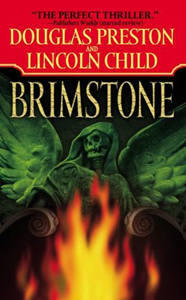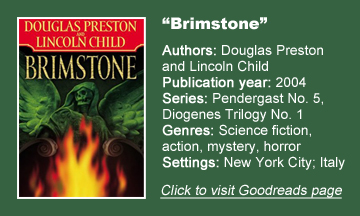For a 700-plus-page doorstop, Douglas Preston and Lincoln Child’s “Brimstone” (2004) is a fun read; you can knock off 100 pages in a sitting without trying. In a New York murder case that spirals into an Italian jaunt, the authors go gung-ho with action and incredible scenarios rather than digging into scientific mysteries.
The latter is more my cup of tea, but this novel solidifies the entertaining opposites-attract friendship between FBI Agent Aloysius Pendergast and police Sergeant Vincent D’Agosta, and it formally introduces us to Pendergast’s ward Constance Greene and long-lost brother Diogenes. Don’t expect a lot of those two though, even though this is technically the first of the Diogenes Trilogy.
A Prestonian effort?
Despite having read their solo works, I can’t tell what each author contributes to their team-ups, but “Brimstone” strikes me as a Prestonian effort. It heavily and arbitrarily features Italy in a similar fashion to Thomas Harris’ “Hannibal.”
Preston would co-write the true crime book “The Monster of Florence” in 2008, and he already has the city on his mind. Worldwide weapons magnate Locke Bullard happens to have a facility there, and another person of interest, Count Fosco, also lives in Italy. D’Agosta’s ancestry is Italian, and while Pendergast is English in origin, he is of course cultured enough to be even more comfortable in Italy than his partner.
Additionally, religion features in the secondary thread, and Preston – whose “Blasphemy” came out in 2008 – seems more interested in that issue than Child.
Supernatural mystery?
The “Reverend” Buck – one of those “climb atop a rock in a park” preachers – is a vintage P&C cartoon, someone who fits a specific mold too well for me to see him as a real person. Yet there’s humor and drama to his desire to play a major role in the Second Coming.
Similar to “Blasphemy,” “Brimstone” posits that an event – in this case a death where someone is burned from the inside, with a devil’s hoof print nearby – can only be explained with the supernatural, but then the authors build toward rational possibilities.
“Brimstone” hits the bestseller equivalent of blockbuster drama in its Central Park showdowns between Buck and NYPD Captain Laura Heyward, whose own circle is peppered with those cartoony types of officials who are better at ass-covering than their jobs.
Romantic partner for D’Agosta
This is the book where D’Agosta and Heyward become a thing, leaving in the dust D’Agosta’s previous family in British Columbia, where he was a crime novelist (!) during the last couple Pendergast novels that he sat out. I’m glad, as the cop deserves something good in his life.
Pendergast is almost an action hero here. I like when he outsmarts a sniper set up across from the Riverside Drive mansion, which is now the agent’s main home after its introduction in “Cabinet of Curiosities.”

In that book, we learned about the inside of the house; here, we learn about the surrounding neighborhood, as D’Agosta’s slightly lost trek through the dark, rundown, scary streets of Harlem serves as a tense travelogue.
Later, Pendergast and D’Agosta walk straight into the enemy’s castle, and Pendergast’s plan – much to his partner’s unease — relies almost entirely on improvisation. But as the agent (through the authors) maybe gets carried away with his self-belief, this book also features the darkest ending so far.
Larger-than-life Fosco
Fosco — borrowed from Wilkie Collins’ “The Woman in White” (1859), one of the first mystery novels – is another colorful, larger-than-life character. The fat man is well-mannered and cultured; his primary interest is the legendary Stradivarius violins.
The authors give us tons of details about the process that makes Strads special, and even though my interest in the topic was low beforehand, I found it to be fascinating reading.
At other times, Fosco is described as “grotesque.” He’s a prime example of how “Brimstone” is a tad less serious than other P&C works. As easy as it is to read, I didn’t get into the mystery. It’s mostly solved in Pendergast’s head, without us being privy to the inner workings of his thoughts.
Gee-wiz sci-fi
Cutting-edge science plays into the case, but a weapon operated by “knobs and dials” ventures into gee-wiz SF territory. Usually the authors give us genuinely fascinating science rather than the goofy variety. On the other hand, the “here’s what happened” chapters make for good reading.
The bigness goes beyond the page count. We’re now trekking around the globe and Diogenes Pendergast – via an ominous letter – is coming for his brother Aloysius.
Meanwhile, the ageless 19th century girl Constance Greene is simply living at the Riverside Drive mansion; while her mysterious nature is flattened on a re-read, it’s still amusing how P&C almost casually pepper bizarre elements into our favorite agent’s personal life, not merely into the cases he works.
“Brimstone” is mostly a standalone yarn, but it’s also an entryway to Pendergast’s wider world.


